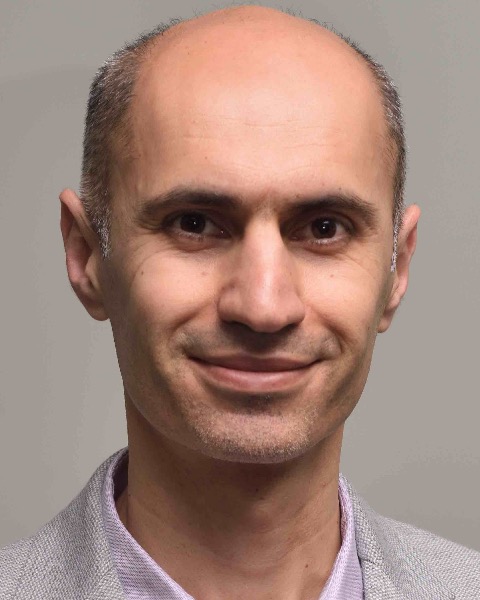Cancer Technologies
Cancer Technologies - Poster Session B
Poster S14 - Engineering a Tunable Composite Hydrogel to Investigate Matrix Stiffness-Mediated Breast Tumor Cell Invasion
Thursday, October 24, 2024
2:45 PM - 3:45 PM EST
Location: Exhibit Hall E, F & G

Anju Rana Magar (she/her/hers)
Research Assistant
The university of Akron
Akron, Ohio, United States
Hossein Tavana, PhD (he/him/his)
Department Chair/ Professor
University of Akron, Ohio, United States
Presenting Author(s)
Primary Investigator(s)
Introduction: The stiffness of breast tumors increases gradually from core to the periphery of the tumor1. The stiffening of the breast tumor environment induces changes in tumor cell phenotype, promoting tumor progression, invasion, and metastasis2. Understanding how extracellular matrix (ECM) stiffness alters breast cancer cell phenotypes such as enhanced invasiveness is critical to develop new treatments that reduce metastasis burden. Our objective was to develop a 3D hydrogel ECM with tunable mechanical stiffness without altering the protein composition of the ECM. We used the hydrogel to study effects of ECM stiffness on epithelial-to-mesenchymal transition (EMT) and local invasion of breast cancer cells.
Materials and
Methods: Collagen-alginate hydrogels were synthesized by combining Type I Collagen (3 mg/ml), low viscosity alginic acid sodium salt (5 mg/ml), 10X EMEM, and cell culture medium3. The pH of the solution was adjusted to neutral, followed by the addition of three different molar concentrations of CaCl2 (5 mM, 15 mM, and 30 mM) to generate hydrogels of varying stiffness, labeled as soft, middle, and stiff, respectively. The mechanical properties of the hydrogels were assessed using a rheometer, measuring storage modulus (G') and loss modulus (G''). The microstructural analysis of the hydrogels was conducted by first lyophilizing the hydrogels and imaging the lyophilized hydrogels with a scanning electron microscope (SEM). Permeability of the hydrogels was evaluated by measuring the diffusion of fluorescein isothiocyanate-labeled dextran (FITC-dextran) (Mw=70 KDa) through the hydrogels over time. SUM-159 cell spheroids were prepared using aqueous two-phase system (ATPS) technology4. These spheroids were encapsulated in composite hydrogels of three distinct stiffness values and invasion of cells from spheroids into the ECM was imaged with confocal microscopy 6 days after encapsulation.
Results, Conclusions, and Discussions: Results and
Discussion:
Rheological measurements showed a progressive increase in both the storage modulus (G’) and the loss modulus (G”) of the hydrogels with increase in CaCl2 concentrations, indicating enhanced stiffness and viscoelastic behavior (Fig. 1a). SEM images showed alterations in the microstructures of the hydrogels across varying calcium crosslinking concentrations, displaying interconnectivity of collagen fibrils and alginate flakes (Fig. 1b). Hydrogels with the highest concentration of CaCl2 (30 mM) displayed compressed and smaller pores due to calcium ion-mediated crosslinking of alginate monomers. The diffusive transport of the macromolecule FITC-dextran through the hydrogels demonstrated their permeability. Over time, the fluorescence intensity of FITC-dextran released through the hydrogels increased. Hydrogels with higher stiffness (associated with higher CaCl2 concentrations) showed reduced FITC-dextran diffusion, potentially due to a tighter matrix packing or smaller pore sizes (Fig. 1c). Furthermore, the encapsulation of SUM-159 breast cancer cell spheroids provided valuable insights into the interplay between hydrogel stiffness and cellular invasion in breast cancer. Our results demonstrate that the stiffness of the hydrogel matrices significantly influences the extent of cellular invasion. Specifically, we observed that cells migrated significantly more within stiffer hydrogels.
Conclusion: Our study highlights the ability to modulate the microstructure, permeability, and mechanical properties of composite hydrogels by varying the cross-linker concentration while maintaining the structural protein content constant. These hydrogels facilitated nutrient and oxygen transport to encapsulated cancer cell spheroids, promoting cell viability and invasion. This hydrogel offers a promising model for mechanistic investigations into how ECM stiffness influences cancer cell signaling, providing insights into potential therapeutic strategies against cancer cell invasion and metastasis.
Acknowledgements (Optional): Funding was provided by NSF grant 2140104 and NIH grant CA225549.
